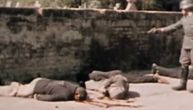"They gave me my daughter's rings to identify her": Distressing testimonies in wake of RTS bombing
The devastating scenes of the bombing of the building, the rubble, the people buried underneath it and those who did not survive, 21 years later are still deeply etched in the memories of their families and colleagues, as well as members of the rescue units who were on duty that night
"The intro had rolled, the news broadcast was starting and suddenly, a deafening explosion and then complete darkness," this is how employees of Radio-Television of Serbia (RTS) describe the night between April 22 and 23, 1999, when NATO bombed their building in Aberdareva Street in Belgrade, killing 16 employees of that broadcaster.
The devastating scenes of the bombing of the building, the rubble, the people buried underneath it and those who did not survive, 21 years later are still deeply etched in the memories of their families and colleagues, as well as members of the rescue units who were on duty that night.
"When I approached the building, there was a horrid scene. The collapsed floor slabs, those poor people... it was all covered in ash," recalled Dragan Cubra of the fire rescue unit, who said the building was unrecognizable under the debris.
"It was only when people started to move things, that one could see there had been something there," he is heard saying in the film, "Chronicle of a Death Foretold."
Zorica Gutesa, a friend of one of the victims, makeup artist Jelica Munitlak, said that after the bombing of the building Jelica's father called her and asked her to send his daughter a message to her pager, and tell her that he was waiting for her in Aberdareva Street.
"The next time he called me, he told me that they had let him identify her rings. I didn't have the courage to say they were hers, instead I said I wasn't sure either," Gutesa recalled.
Ivica Stojkovic, the shift leader at RTS at the time, remembers that it was raining, which made it even more difficult that night, and that he was standing on the ruins with the son of his colleague Bane, who had been killed.
"Bane's son was by my side, I think he was about 15 or 16 years old at the time. He spoke to me, asked if there was a chance his dad was alive. What was I supposed to tell him? Those were tough days," he said, adding that this was a terrible story.
Milena Vucetic, director of the RTS technical department, says that she had her first conversation with the father of another victim, Ksenija, but did not have the strength to tell him that "his Ksenija was gone."
CNN knew, but did not announce that the RTS building would be bombed
At 2:06 am on April 23, 1999, NATO attacked the Radio-Television of Serbia (RTS) building, killing 16 media workers.
For the first time in the history of warfare, a media outlet that was previously declared a legitimate military target was attacked. The RTS building was bombed during a news broadcast.
Former RTS director Dragoljub Milanovic was sentenced to 10 years in prison in Belgrade in 2002 for failing to obey the orders of the federal government at the time and move people and equipment from RTS facilities in Aberdareva and Hilandarska streets.
On April 21, 1999, CNN reporters in Belgrade, Brent Sadler and Alessio Vinci, told the then RTS director that an attack on the media outlet was going to take place, but neither he nor CNN executives, who had been notified by the US government - informed the public.
Milanovic was released from prison on September 1, 2012.
(Telegraf.rs)

